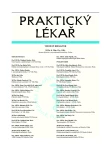Addictive disease and money – relevant connections
Authors:
K. Nešpor 1; A. Scheansová 2
Authors‘ workplace:
Odděleni léčby závislostí – muži
Primář: MUDr. Karel Nešpor, CSc.
Psychiatrická léčebna Bohnice, Praha
Ředitel: MUDr. Martin Hollý
; Institut postgraduálního vzdělávání ve zdravotnictví, Praha
Ředitel: Mgr. et Bc. Radim Gabriel
2
Published in:
Prakt. Lék. 2009; 89(8): 447-449
Category:
Of different specialties
Overview
Alcohol, other addictive drugs and gambling go in for society economically inconvenient. Claims that the functions, aren’t from compensated taxation. Just taxation at the same time presents highly effective instrument prevention. Uncontrolled and easily possible financial resources and surd access to economic conditions in family constitute risk factor especially for children and adolescent. But also lack of funds and poverty constitute risk factor and in addition make more difficult big groups population access to special medical modality (psychotherapy or usage expensive medicines). Money and standard of living are often significant motivational factors at treatment addictive illness. Treatment and especially prevention addictive illness are budget for individuals, families and society.
Key words:
addictive disease, prevention, treatment, psychotherapy, family therapy.
Sources
1. Baumann, M., Spitz, E., Guillemin, F. et al. Associations of social and material deprivation with tobacco, alcohol, and psychotropic drug use, and gender: a population-based study. Int J Health Geogr. 2007, 6, 50.
2. Bush, T.M., McAfee, T., Deprey, M. et al. The impact of a free nicotine patch starter kit on quit rates in a state quit line. Nicotine Tob. Res. 2008, 10(9), p. 1511-1516.
3. Dutra, L., Stathopoulou, G., Basden, S.L. et al. A meta-analytic review of psychosocial interventions for substance use disorders. Am. J. Psychiatry 2008, 165(2), p. 179-187. http://ajp. psychiatryonline.org/cgi/content/full/165/2/179, accessed 1. 4. 2009
4. Fleming, M.F., Mundt, M.P., French, M.T. et al. Benefit-cost analysis of brief physician advice with problem drinkers in primary care settings. Med. Care 2000, 38(1), p. 7-18.
5. Gollust, S.E., Schroeder, S.A., Warner, K.E. Helping smokers quit: understanding the barriers to utilization of smoking cessation services. Milbank Q. 2008, 86(4) p. 601-627.
6. Haustein, K.O. Smoking and poverty. Eur. J. Cardiovasc. Prev. Rehabil. 2006, 13(3) p. 312-318.
7. Jha, P., Chaloupka, F.C. Curbing the epidemic: Governments and the economics of tobacco control. The World Bank 1999. Available: http://www. worldbank.org/tobacco/.
8. Johansson, E., Böckerman, P., Uutela, A. Alcohol consumption and sickness absence: evidence from microdata. Eur. J. Public Health 2009,19(1), p. 19-22.
9. Koski, A., Sirén, R., Vuori, E. Poikolainen, K. Alcohol tax cuts and increase in alcohol-positive sudden deaths: a time-series intervention analysis. Addiction 2007, 102(3), p. 362-368.
10. Nešpor, K. Návykové chování a závislost. Třetí aktualizované vydání. Praha: Portál 2007, s. 176.
11. Markowitz, S., Chatterji, P., Kaestner, R. Estimating the impact of alcohol policies on youth suicides. J. Ment. Health. Policy Econ. 2003, 6(1) p. 37-46.
12. Rockloff, M.J., Schofield, G. Factor analysis of barriers to treatment for problem gambling. J. Gambl. Stud. 2004, 20(2) p. 121-126.
13. Segal, D.S., Stockwell, T. Low alcohol alternatives: a promising strategy for reducing alcohol related harm. Int. J. Drug. Policy 2009, 20(2), p. 183-187.
14. Shapiro, M. Money: a therapeutic tool for couples therapy. Fam. Process. 2007, 46(3), p. 279-291.
15. Siahpush, M., Wakefield, M.A., Spittal, M.J. et al. Taxation reduces social disparities in adult smoking prevalence. Am. J. Prev. Med. 2009, 36(4), p. 285-291.
16. Sigmon, S.C., Higgins, S.T. Voucher-based contingent reinforcement of marijuana abstinence among individuals with serious mental illness. J. Subst. Abuse Treat. 2006, 30(4) p. 291-295.
17. van den Berg, M., van Baal, P.H., Tariq, L. et al. The cost-effectiveness of increasing alcohol taxes: a modelling study. BMC Med. 2008, 6, p. 36. www.biomedcentral.com/1741-7015/6/36.
18. Volpp, K.G., Troxel, A.B., Pauly, M.V. et al. A randomized, controlled trial of financial incentives for smoking cessation. N. Engl. J. Med. 2009, 360(7), p. 699-709.
19. Wagenaar, A.C., Salois, M.J., Komro, K.A. Effects of beverage alcohol price and tax levels on drinking: a meta-analysis of 1003 estimates from 112 studies. Addiction 2009, 104(2), p. 179-190.
20. Wood, W.D. Do fees help heal? J. Clin. Psychol. 1982, 38(3) p. 669-673.
21. Wu, L.T., Kouzis, A.C., Schlenger, W.E. Substance use, dependence, and service utilization among the US uninsured nonelderly population. Am. J. Public. Health 2003, 93(12), p. 2079-2085.
22. Zarkin, G.A., Bray, J.W., Aldridge, A. et al. COMBINE Cost-Effectiveness Research Group. Cost and cost-effectiveness of the COMBINE study in alcohol-dependent patients. Arch. Gen. Psychiatry 2008, 65(10), p. 1214-1221.
Labels
General practitioner for children and adolescents General practitioner for adultsArticle was published in
General Practitioner

2009 Issue 8
Most read in this issue
- The calcium score: helper or a bad counsellor in diagnostics of chest pain suspected of coronary origin
- Prostate cancer in the age of the da Vinci robotic radical prostatectomy
- Incidence of pulmonary embolism in females aged 15–25 years in relation to oral contraception use (Results of a five-year study)
- Prevention of venous thrombosis (phlebothromboprophylaxis) in clinical practice
